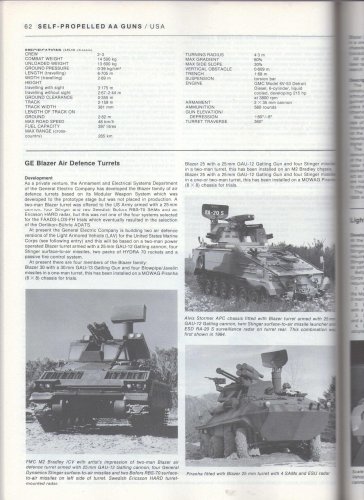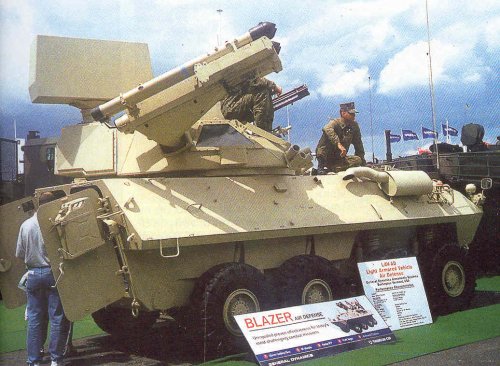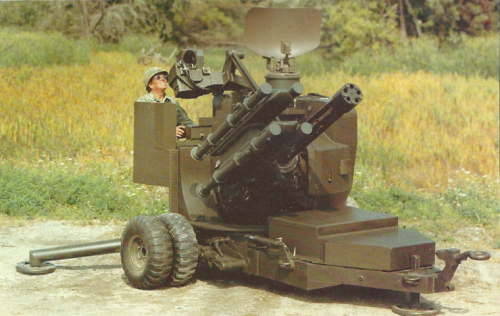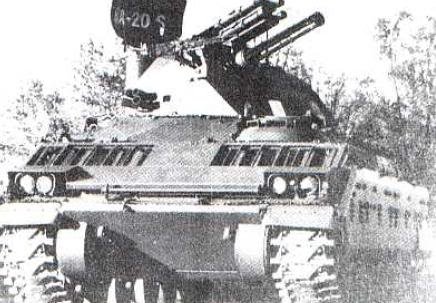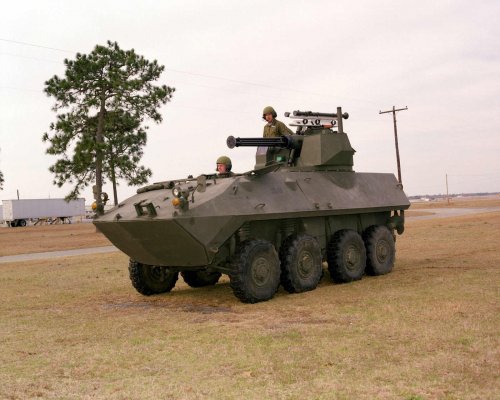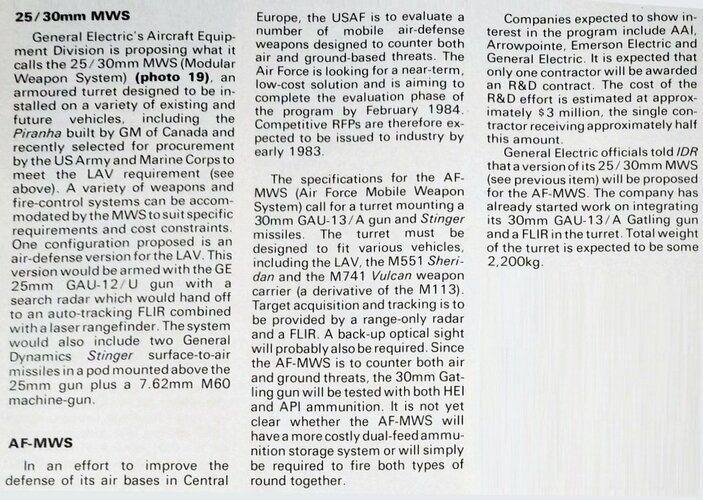You are using an out of date browser. It may not display this or other websites correctly.
You should upgrade or use an alternative browser.
You should upgrade or use an alternative browser.
GE Blazer air defence turrets
- Thread starter tround
- Start date
- Joined
- 21 April 2009
- Messages
- 13,565
- Reaction score
- 7,191
Always thought this would make a great anti-personnel weapon called the "Street Sweeper" A Stryker platform with the acoustic sniper detection system coupled with 'slew to cue' software/attack mechanism. Imagine a sniper taking a shot and the turret immediately finding the snipers location and unleashing a thousand rounds in a 10+ second burst.
Result dead sniper long term result anytime that Stryker was in the neighbourhood no more snipers. I read somewhere that the Soviets would use the ZSU-23 as an anti-personnel weapon in A-stan.
Result dead sniper long term result anytime that Stryker was in the neighbourhood no more snipers. I read somewhere that the Soviets would use the ZSU-23 as an anti-personnel weapon in A-stan.
C
CostasTT
Guest
Re: ZSU-23-4... Not only did they use it in the APERS role, but they went so far as to remove the radar and AA related electronics and double the ammo load. Needless to say, the vehicle earned the nickname "Satan's Chariot".
Back to the Blazer turret...
I had these pics in my HDD. Enjoy!
Back to the Blazer turret...
I had these pics in my HDD. Enjoy!
Attachments
-
 M1047 LAVAD_01.jpg42.5 KB · Views: 547
M1047 LAVAD_01.jpg42.5 KB · Views: 547 -
 M1047 LAVAD_03.jpg39.5 KB · Views: 424
M1047 LAVAD_03.jpg39.5 KB · Views: 424 -
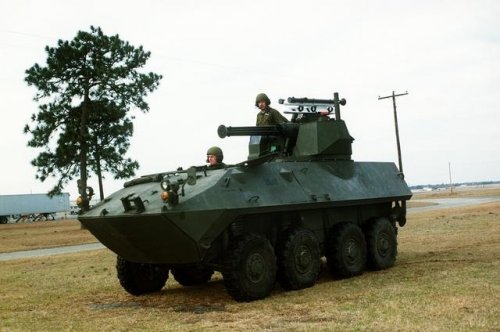 M1047 LAVAD_05.JPG124.1 KB · Views: 425
M1047 LAVAD_05.JPG124.1 KB · Views: 425 -
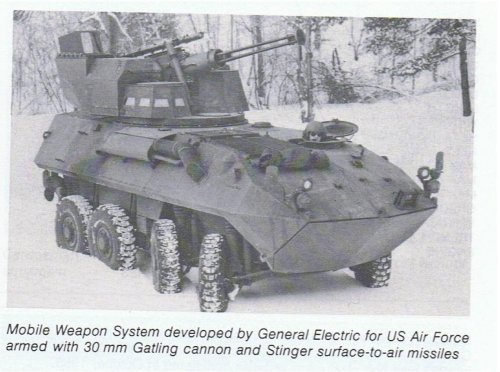 M1047 LAVAD_07.jpg153.1 KB · Views: 457
M1047 LAVAD_07.jpg153.1 KB · Views: 457 -
 LAV-AD_03.jpg51.4 KB · Views: 450
LAV-AD_03.jpg51.4 KB · Views: 450 -
 Bradley Blazer with 3 barrel 30mm.jpg13.8 KB · Views: 614
Bradley Blazer with 3 barrel 30mm.jpg13.8 KB · Views: 614 -
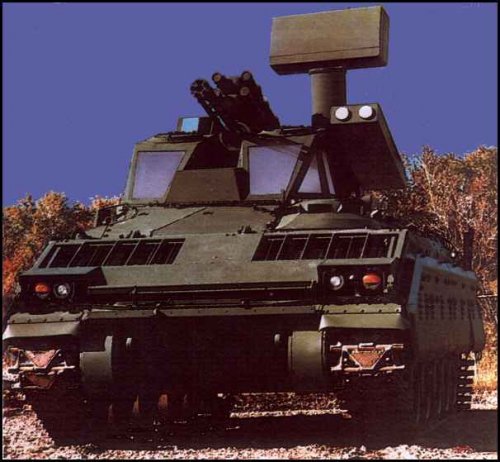 bradley blazer.jpg32.9 KB · Views: 598
bradley blazer.jpg32.9 KB · Views: 598 -
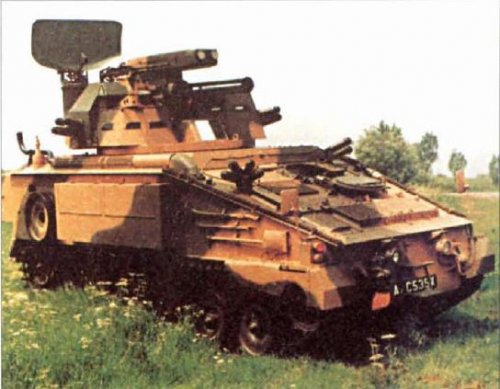 Stormer SPAA vehicle_01.JPG39.1 KB · Views: 596
Stormer SPAA vehicle_01.JPG39.1 KB · Views: 596
C
CostasTT
Guest
- Joined
- 18 March 2008
- Messages
- 3,529
- Reaction score
- 880
There was also the towed Blazer system. The GE Lightweight Air Defense System (LADS) which was developed from the GEMAG 25 to provide a M167 Vulcan replacement for the US Army in the 1980s. GEMAG 25 had a 25mm GAU-12/U gun, four Stingers and a Dassault surveillance radar that could detect and track two targets at a range of up to 11km. 757 rounds of 25mm are carried on the towed mount.
Attachments
Is that 3-barrel 30mm gatling the CHAG? The Compact High-performance Aircraft Gun was a lightweight version of the GAU-8 and GAU-13 guns, firing the same 30x173 ammo at about 2000 rpm.
The only other 3-barrel 30mm I'm aware of is the XM188, but that was a low-velocity helo gun in 30x100B, so not of much use for air defence.
The only other 3-barrel 30mm I'm aware of is the XM188, but that was a low-velocity helo gun in 30x100B, so not of much use for air defence.
C
CostasTT
Guest
If you are referring to the Bradley Blazer, I'm not sure. All other rotary 30s seem 4-barreled to me, but I found two slightly bigger pics of the vehicle in question, and one is captioned as being an Equalizer (25mm) armed example.
http://commi.narod.ru/txt/1995/19950803.jpg
http://home.arcor.de/acidphreak/panzer.jpg
Thus, maybe the original name of my pic was wrong.
http://commi.narod.ru/txt/1995/19950803.jpg
http://home.arcor.de/acidphreak/panzer.jpg
Thus, maybe the original name of my pic was wrong.
What about the LAVAD?
C
CostasTT
Guest
4 barrels, I think.
Presumably it's the GAU-13/A, then.
C
CostasTT
Guest
- Joined
- 21 May 2006
- Messages
- 2,833
- Reaction score
- 1,915
A great system if you ask me! Better and more effective than the U.S. Army's Avenger system, with it's punitive 12.7mm MG!
Now doesn't the Stormer-based Blazer look a more sensible and balanced looking platform, as opposed to the larger, heavier and much more expensive Bradley-based proposal!)
Now if only I could get the Australian Government and Army to adopt such a basic, but effective system on about 20-odd LAV chassis!! :
Regards
Pioneer
Now doesn't the Stormer-based Blazer look a more sensible and balanced looking platform, as opposed to the larger, heavier and much more expensive Bradley-based proposal!)
Now if only I could get the Australian Government and Army to adopt such a basic, but effective system on about 20-odd LAV chassis!! :
Regards
Pioneer
C
CostasTT
Guest
The Stormer sure looks nice with the Blazer turret, but I think there would be certain issues with insufficient ammunition capacity and maybe recoil, especially when firing to the side, unless a suspension locking system was fitted.
A youtube vid of a LAV-AD firing demonstration:
http://www.youtube.com/watch?v=XooFmPUt6aA
And a hi-res version of a previously posted pic:
A youtube vid of a LAV-AD firing demonstration:
http://www.youtube.com/watch?v=XooFmPUt6aA
And a hi-res version of a previously posted pic:
Attachments
- Joined
- 21 May 2006
- Messages
- 2,833
- Reaction score
- 1,915
Does anyone know what year the USMC phased out its LAV-AD's and what was the Marine's official reasoning for doing so?
I've read that the USMC originally intended aquiring 125 x LAV-AD's, but in the end only ended up taking up a measly seventeen.
Regards
Pioneer
I've read that the USMC originally intended aquiring 125 x LAV-AD's, but in the end only ended up taking up a measly seventeen.
Regards
Pioneer
If I remember right, it went down to a combination of money and not effective enough. Low-caliber, rapid-fire AAGs are slowly being phased out by most nations that can make the shift, largely thanks to HEPF rounds being widely available at smaller calibers since the '70s (when Bofors unveiled their 40mm HEPF round, which would later get used in the disastrous Sgt. York program).Does anyone know what year the USMC phased out its LAV-AD's and what was the Marine's official reasoning for doing so?
I've read that the USMC originally intended aquiring 125 x LAV-AD's, but in the end only ended up taking up a measly seventeen.
Regards
Pioneer
- Joined
- 21 May 2006
- Messages
- 2,833
- Reaction score
- 1,915
Thank you for your reply GruntFox, but the USMC didn't replace the LAV-AD's at all, did they?If I remember right, it went down to a combination of money and not effective enough. Low-caliber, rapid-fire AAGs are slowly being phased out by most nations that can make the shift, largely thanks to HEPF rounds being widely available at smaller calibers since the '70s (when Bofors unveiled their 40mm HEPF round, which would later get used in the disastrous Sgt. York program).Does anyone know what year the USMC phased out its LAV-AD's and what was the Marine's official reasoning for doing so?
I've read that the USMC originally intended aquiring 125 x LAV-AD's, but in the end only ended up taking up a measly seventeen.
Regards
Pioneer
Regards
Pioneer
The sad reality is that the marines rarely get a lot of funding, so they always had to make do with whatever scraps the US Army gives them. It should also be noted that the USAF has a disturbing tendency to basically veto as many AA programs as they could get away with. That is why the US has lackluster AA for anything not the Navy.Thank you for your reply GruntFox, but the USMC didn't replace the LAV-AD's at all, did they?If I remember right, it went down to a combination of money and not effective enough. Low-caliber, rapid-fire AAGs are slowly being phased out by most nations that can make the shift, largely thanks to HEPF rounds being widely available at smaller calibers since the '70s (when Bofors unveiled their 40mm HEPF round, which would later get used in the disastrous Sgt. York program).Does anyone know what year the USMC phased out its LAV-AD's and what was the Marine's official reasoning for doing so?
I've read that the USMC originally intended aquiring 125 x LAV-AD's, but in the end only ended up taking up a measly seventeen.
Regards
Pioneer
Regards
Pioneer
isayyo2
Lurker alert
- Joined
- 24 November 2011
- Messages
- 1,087
- Reaction score
- 2,149
I think it's been mentioned somewhere else here, but the linked article mentioned the AF-MWS program. The Air Force - Mobile Weapons System was to be a 30mm GAU-13 and Stinger turret capable of being mounted on the LAV/M1047, M551, and M163. AAI, Arrowpointe, Emerson Electric, and GE were expected to submit designs with an evaluation in 1984; presumably the evaluation never happened?
Colonial-Marine
UAVs are now friend, drones are the real enemy.
- Joined
- 5 October 2009
- Messages
- 1,378
- Reaction score
- 1,135
There is nothing wrong with the Bofors 40mm L/70 but it seems like the Oerlikon 35mm would have been just as good of a choice.
Or go with something with missile for greater ranges and a 25mm GAU-12 or 30mm GAU-13 for anything closer. I think the ideal system would have been something combining one of those two with ADATS but that ADATS wasn't until the late '80s, early 90s.
Or go with something with missile for greater ranges and a 25mm GAU-12 or 30mm GAU-13 for anything closer. I think the ideal system would have been something combining one of those two with ADATS but that ADATS wasn't until the late '80s, early 90s.
The York would have gotten a lot of praise largely because of its reactiveness (when not causing the turret crew to get sick from the turret revolutions or having it's 3k PSI hydraulics fail, please note that the team were going to replace said hydraulics with 5k PSI models in the next test version) and the fact that it can use HEPF ammunition.There is nothing wrong with the Bofors 40mm L/70 but it seems like the Oerlikon 35mm would have been just as good of a choice.
Or go with something with missile for greater ranges and a 25mm GAU-12 or 30mm GAU-13 for anything closer. I think the ideal system would have been something combining one of those two with ADATS but that ADATS wasn't until the late '80s, early 90s.
Let me dig out a quote from one of the test pilots that went against the York (a Tom Farrier Retired USAF rescue helicopter pilot; current aviation safety contractor (UAS) said):
In 1982 I participated in both cooperative and non-cooperative tests at Aberdeen Proving Grounds in Maryland, flying an Air Force CH-3E helicopter against a Sergeant York. I would have been dead many times over had it been shooting live rounds at us instead of just video.
The Sergeant York was the front-runner in a program intended to provide the Army with a sorely needed “division air defense” (DIVAD) weapon system. It was based on a novel concept: re-purposing M48 Patton tank chassis’ with a new turret incorporating twin Swedish Bofors 40mm cannons and two radar systems — one for area surveillance (the rectangular antenna) and one for targeting (the conical antenna, an off-the-shelf application of the F-16′s radar).
A firing control system integrated the two radars, with on-board software prioritizing targets based on the threat they were assessed to pose to the system itself. (For the late ’70s /early ’80s, this was cosmic.) If the operator elected to allow the system to engage targets hands-off, it would slew the turret around at a nauseatingly rapid rate, taking on each in turn automatically.
On the next-to-last day of the test, my aircraft was joined by an Army AH-1 Cobra and OH-58 Kiowa and two Air Force A-10s. My H-3 was part of the test profile because its radar signature was essentially the same as that of an Mi-24 HIND assault helicopter of the day, which was heavily armed with both anti-tank missiles and rockets. We all converged on it simultaneously from about 6000 meters. My aircraft was the first to die, followed by the two A-10s, then the Cobra, and finally the Kiowa. It took less than 15 seconds to put plenty of hypothetical rounds into each of us.
I spent a depressing amount of that week watching myself get tracked and killed on video. Trying to “mask” behind anything other than rising terrain simply didn’t work; the DIVAD radar got a nice Doppler return off my rotor system if any part of it was within its line of sight, and it burned right through trees just fine. I couldn’t outrun or out-maneuver it laterally; when I moved, it tracked me. I left feeling pretty convinced that it was the Next Big Thing, especially since I’d come into the test pretty cocky thanks to having had a lot of (successful) exercise experience against current Army air defense systems.
So, what happened to the program itself? I think it was a combination of factors. First, the off-the-shelf concept was cool as far as it went, but the Patton design already was a quarter-century old; the DIVAD was awfully slow compared with the M1 Abrams tanks it was supposed to protect. It would have had a lot of trouble keeping up with the pack.
Second, The Atlantic Monthly published a really nasty article (bordering on a hatchet job) purporting to show the program was a complete failure and a ruinous waste of money. One of its most impressive bits of propaganda was an anecdote about a test where the system — on full automatic — took aim at a nearby trailer full of monitoring equipment. Paraphrasing, “It tracked and killed an exhaust fan,” chortled the author. (See The Gun That Shoots Fans for a recounting of this.)
Yeah, it did. It was designed to look for things that rotate (like helicopter main rotor systems) and prioritize them for prompt destruction. If any bad guys were on the battlefield in vehicles with unshrouded exhaust fans, they might have been blown away rather comprehensively. (My understanding at the time was that said fan was part of a rest room in one of the support vehicles and not a “latrine,” but why mess up a good narrative, right?)
To my knowledge, neither ventilated latrines nor RVs full of recording devices are part of a typical Army unit’s table of allowance, so I really doubt there was much of a fratricide threat there. However, the bottom line was that this particular piece of partisan reporting beat the crap out of a program that I believe the Army needed, but already was facing a few developmental issues, and helped hasten its cancellation.
(The New York Times opinion piece linked to above was equally laden with innuendo and assumptions. It made a fair point about possible anti-radiation attacks it might have invited… but there are radars on every battlefield, and there are means of controlling emissions. It compared a late-Fifties era Soviet system — the ZSU-23–4 — with one fully twenty years newer in design. It asserted that it couldn’t hit fixed-wing aircraft, which to my mind and personal observation was arrant nonsense. The only issue it raised that I agree with was possible NATO compatibility problems with the unique 40mm caliber shells the Sergeant York’s guns fired. Funny — the Times pontificated that it wouldn’t be cancelled, too. Oops.)
Third, the hydraulics that were used in the prototype were a 3000 psi system that really couldn’t handle the weight of the turret in its Awesome Hosing Things mode. One of the only times I actually got a score on the system was when I cheated; I deliberately exploited that vulnerability. I flew straight toward the system (which would have blown us out of the sky about twenty times over had I tried to do so for real) until directly over it, then tried to defeat the system from above.
If memory serves, the system specifications called for the guns to elevate to more than 85 degrees if something was coming up and over; it then would lower them quickly, slew the turret 180 degrees around, and raise the guns again to re-engage. It was supposed to be able to do that in perhaps ten seconds (but I’m here to tell you it did it a lot faster than that). So, I had my flight engineer tell me the moment the guns dropped, at which point I did a course reversal maneuver to try to catch it pointed the wrong way. What the video later showed was:
The hydraulics hadn’t been able to support the multiple close-on, consecutive demands of movement in multiple axes and failed. Like I said, I cheated. The Army and the contractors already knew about this problem and were going to fit out production models with a 5000 psi system. That might have had some survivability issues of its own, but the Army was perfectly happy that we’d done what we did — it proved the test wasn’t rigged and underscored the need for the production change.
- Helicopter flies over.
- Traverse/re-acquire movement starts.
- Helicopter initiated hammerhead turn (gorgeous, if I say so myself).
- Guns started to elevate to re-engage.
- Clunk. Guns fall helplessly down; DIVAD crew uses bad language.
Finally, the Army itself honestly appraised the system based on its progress (and lack of progress) versus their requirements. Wikipedia provides a passage that encapsulates this end-game well: “The M247 OT&E Director, Jack Krings, stated the tests showed, ‘...the SGT YORK was not operationally effective in adequately protecting friendly forces during simulated combat, even though its inherent capabilities provided improvement over the current [General Electric] Vulcan gun system. The SGT YORK was not operationally suitable because of its low availability during the tests.’ ”
I guess I’m forced to conclude that the Sergeant York was a really good concept with some definite developmental flaws — some recognized and being dealt with, perhaps one or two that would have made it less than fully effective in its intended role — that was expensive enough for bad PR to help bring it down before it fully matured. The Army was under a lot of political pressure to get it fielded, but to their credit they decided not to potentially throw good money after bad.
On balance, a lot of the contemporaneous criticisms mounted against the M247 really don’t hold up very well over time. Short-range air defense currently is provided by the latest generation of the AN/MPQ-64F1 Improved Sentinel system. Radar emitting on the battlefield? Check. Target prioritization capabilities? Check. Towed (which equals “slow”) versus self-propelled? Check.
I’m glad we never wound up in the position of needing it but not having it. My personal judgment was and is that it probably could have wound up a heck of a lot more capable and useful than its developmental history might suggest, but its cancellation probably was justified given other acquisition priorities at the time.
Bottom line: I repeatedly flew a helicopter against it over the course of many hours of testing, including coming at it as unpredictably as I knew how, and it cleaned my clock pretty much every time.
Basically, it was going to be a particularly nasty customer but between development problems, the USAF being itself, and very piss poor PR... it got canned.
Kat Tsun
eeeeeeeeeeeeeee
- Joined
- 16 June 2013
- Messages
- 1,200
- Reaction score
- 1,531
XM246 was way better as Afghanistan and Iraq prove.
Not sure how the USAF kills Sergeant York since the SecAF has no say in what the SecArmy wants to buy.
The real killer of Sergeant York of any caliber or radar setup, including ones that would work in practice, is that the M48 was old and M60 wasn't much better. They were both terrible automotive platforms for an ostensibly modern air defense vehicle. M1 would have been better as a mount, or something with Bradley's powerpack, but that was beyond means.
Even if Army had decided to use M60s, it would have been obsolete by the mid-90's, and in dire need of replacement, which wouldn't happen. A bullet dodged, really.
Not sure how the USAF kills Sergeant York since the SecAF has no say in what the SecArmy wants to buy.
The real killer of Sergeant York of any caliber or radar setup, including ones that would work in practice, is that the M48 was old and M60 wasn't much better. They were both terrible automotive platforms for an ostensibly modern air defense vehicle. M1 would have been better as a mount, or something with Bradley's powerpack, but that was beyond means.
Even if Army had decided to use M60s, it would have been obsolete by the mid-90's, and in dire need of replacement, which wouldn't happen. A bullet dodged, really.
Not sure how the USAF kills Sergeant York since the SecAF has no say in what the SecArmy wants to buy.
The Air Force was actually frustrated DIVAD failed because its mission was partially air base defense.
The failure led to some sour grapes, especially since it came after the Air Force only learned about Roland's cancellation in the Army’s budget submission to Congress.
The Air Force was deeply concerned the Army wasn't making its air defense responsibilities a priority in the 80s - quite the opposite of somehow vetoing them.
Last edited:
Sgt_Miller
ACCESS: Confidential
- Joined
- 17 November 2019
- Messages
- 51
- Reaction score
- 73
- Joined
- 16 April 2008
- Messages
- 9,048
- Reaction score
- 12,815
I want to confirm something. Is this Blazer the same thing as ADGILE (Air Defense Gun Missile Experiment) that was evaluated by US Army back in 1982-83? Some sources mentioned that ADGILE used the combination of GAU-12/U and Stinger in the same mounting.
I don't believe so. Blazer was a turreted solution, for armored vehicles. LADS was a Lightweight Air Defense system for light infantry and airmobile units.
LADS was originally conceived of as a 40mm gun (probably to match DIVADS) but this study convinced them to adopt a combination of Stinger plus a gun. AFAIK, LADS never settled on a final configuration, but there were towed mounts with Stinger and either 20mm and 25mm Gatling guns that might have been candidates. (And the 25mm version is even mentioned upthread here) Eventually, Avenger took over the role, more or less.
Air Defense Artillery
books.google.com
Sgt_Miller
ACCESS: Confidential
- Joined
- 17 November 2019
- Messages
- 51
- Reaction score
- 73
I'm quite confused by the naming. I knew that there were several bunches of gun + missile experiments/prototypes in the '80s, and LADS was one of them. From what you said, I inferred that LADS must be a towed air defense system since Blazer was a turreted one, am I wrong?I don't believe so. Blazer was a turreted solution, for armored vehicles. LADS was a Lightweight Air Defense system for light infantry and airmobile units.
LADS was originally conceived of as a 40mm gun (probably to match DIVADS) but this study convinced them to adopt a combination of Stinger plus a gun. AFAIK, LADS never settled on a final configuration, but there were towed mounts with Stinger and either 20mm and 25mm Gatling guns that might have been candidates. (And the 25mm version is even mentioned upthread here) Eventually, Avenger took over the role, more or less.
Someone above mentioned MWS turret (Mobile Weapon System), which was also using the combination of 25/30mm Gatling gun + Stinger. So, this MWS (not the AF-MWS) is the Blazer?
Attachments
- Joined
- 21 May 2006
- Messages
- 2,833
- Reaction score
- 1,915
Very interesting drejr! A very different narrative I'm accustomed to.Not sure how the USAF kills Sergeant York since the SecAF has no say in what the SecArmy wants to buy.
The Air Force was actually frustrated DIVAD failed because its mission was partially air base defense.
The failure led to some sour grapes, especially since it came after the Air Force only learned about Roland's cancellation in the Army’s budget submission to Congress.
The Air Force was deeply concerned the Army wasn't making its air defense responsibilities a priority in the 80s - quite the opposite of somehow vetoing them.
Sorry, I've said it before and I'll say it again, I'm completely and utterly flabbergasted by the US Army's ability not to be able to field an effective battlefield air defence system, let alone the total $ cost $ expended Post-WWII of all these programs.....
Honestly how do you screw up an off-the-shelf system??
Regards
Pioneer
- Joined
- 21 May 2006
- Messages
- 2,833
- Reaction score
- 1,915
Interesting book thanks TomS!I want to confirm something. Is this Blazer the same thing as ADGILE (Air Defense Gun Missile Experiment) that was evaluated by US Army back in 1982-83? Some sources mentioned that ADGILE used the combination of GAU-12/U and Stinger in the same mounting.
I don't believe so. Blazer was a turreted solution, for armored vehicles. LADS was a Lightweight Air Defense system for light infantry and airmobile units.
LADS was originally conceived of as a 40mm gun (probably to match DIVADS) but this study convinced them to adopt a combination of Stinger plus a gun. AFAIK, LADS never settled on a final configuration, but there were towed mounts with Stinger and either 20mm and 25mm Gatling guns that might have been candidates. (And the 25mm version is even mentioned upthread here) Eventually, Avenger took over the role, more or less.

Air Defense Artillery
books.google.com
I especially like and appreciate the Chronology segments.
I particularly like and endorser the following under the Dart ATGM segment:
"Although 105 of these antitank missiles were produced, the system was never deployed. Instead, in 1958, the Army decided to field the French SS-l0 which was cheaper; lighter; smaller; and more manageable, accurate, and reliable than the DART."
Regards
Pioneer
Last edited:
Honestly how do you screw up an off-the-shelf system??
Regards
Pioneer
Roland wasn't really off-the-shelf - the Army wanted a domestic production base, a US launch vehicle, and upgraded missile systems and ECM. I'm not sure anything was left but the shape of the missile.
- Joined
- 21 May 2006
- Messages
- 2,833
- Reaction score
- 1,915
Hence this is were the US Army is to blame and should have been held to full account and responsibility IMO my dear drejr, for the Roland was an excellent short range air defence missile system on its own merit, which didn't need to be bastardised.Honestly how do you screw up an off-the-shelf system??
Regards
Pioneer
Roland wasn't really off-the-shelf - the Army wanted a domestic production base, a US launch vehicle, and upgraded missile systems and ECM. I'm not sure anything was left but the shape of the missile.
Regards
Pioneer
trajan
ACCESS: Confidential
- Joined
- 23 October 2020
- Messages
- 116
- Reaction score
- 160
air defence turrets with gau-12 and gau-13 gatling gunw
Similar threads
-
-
-
Divisional Air Defense System (DIVAD / DIVADS) Proposals
- Started by RyanC
- Replies: 178
-
-
Army Indirect Fire Protection System and New Guided Missile Program
- Started by bobbymike
- Replies: 827

